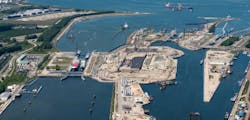Blueprint Power helping American Red Cross reduce Carbon Footprint at Facilities
The American Red Cross, one of the nation's biggest humanitarian non-profit organizations, is moving foward with a new program to reduce its carbon footprint and embrace distributed energy resources at many of its administrative sites.
Energy efficiency technology firm Blueprint Power will work with the American Red Cross on accelerating the latter’s energy transition toward decarbonizing its building footprint.
“We are committed to doing our part to help mitigate the climate crisis and reduce our environmental footprint,” said Noel Anderson, chief sustainability officer for the American Red Cross. “Our work with Blueprint Power is an important step in analyzing and reducing our emissions.”
Among those projects where the Red Cross is working with Blueprint Power includes three facilities in Burlington, Vermont, New York City and West Henrietta, New York. Those three sites will be early adopters in installing energy usage data technology, analytics and efficiency tools to understand and reduce building energy use. (story continues after links)
Related Energy Efficiency stories at EnergyTech
Vermont Regulators considering District Heating project to serve Burlington Medical Center
$98M Chico State University project promises first Net-Zero Building on Campus
Blueprint’s platform and proprietary in-building analytics will then allow the Red Cross to visualize and identify ‘quick win’ site energy investments and energy management optimizations, while supporting enhanced operational improvements and carbon reporting capabilities.
"Blueprint Power is proud to help life-saving organizations like the American Red Cross achieve its sustainability goals," said Robyn Beavers, CEO of Blueprint Power. "Through our combined energy markets expertise and innovative technology, we can enable the organization to generate new revenue streams from its buildings’ flexible energy capacity. This means that the Red Cross can put more money toward supporting those in need while also working towards its sustainability goals.”
The American Red Cross eventually plans to roll out improvements across hundreds of its buildings nationwide, reducing the carbon footprint of some 11 million square feet of property.
In November 2022 the non-profit unveiled rooftop solar construction that will help its Tinton Falls, New Jersey facility to reach net zero status. Brooklyn-based Ecogy Energy is the solar developer on the 120-kW project which generate about 2.7-GWh of carbon-free electricity over the next 20 years, according to reports.
The American Red Cross has consistently ranked as one of the most popular and recognizable humanitarian groups in the U.S., going to sites to provide relief during floods, tornadoes, earthquakes and wildfires. The ARC’s annual revenue is close to $3 billion.
In 2021, the organization released a statement on climate change and vowed to pursue energy sustainability goals that reduce greenhouse gas emissions.
“Climate change is a humanitarian crisis,” the Red Cross statement read. “Every day, the American Red Cross sees the heartbreak of families and communities trying to cope with more intense storms, heavier rainfall, higher temperatures, stronger hurricanes and more devastating wildfires.
“Helping people prepare for, respond to, and recover from disasters has been at the heart of the Red Cross mission since our founding,” it added. “It is through this lens that we see climate change as a serious and devastating threat for the 21st century.”
Blueprint Power, meanwhile, works on energy efficiency and decarbonization strategies with numerous real estate clients which own more than 100 million square feet of commerial property.
-- -- --
(Rod Walton, senior editor for EnergyTech, is a 15-year veteran of covering the energy industry both as a newspaper and trade journalist. He can be reached at [email protected]).
Follow us on Twitter @EnergyTechNews_ and @rodwaltonelp and on LinkedIn





